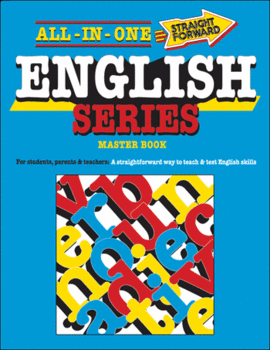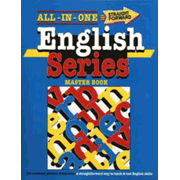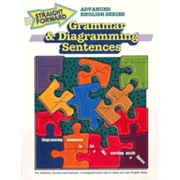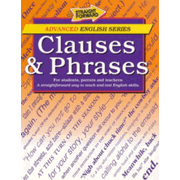All-in-One Straightforward English Series Master Book offers a concise approach to English grammar that might be useful in a number of situations. The book starts with a “Beginning Assessment Test.” This seven-page assessment helps you identify areas of weakness. There’s no need for a student to study something he or she has already mastered.
The bulk of the book is about 100 pages of straightforward instruction on the various points of grammar: capitalization, punctuation, nouns, pronouns, verbs, adjectives, adverbs, prepositions, conjunctions, and interjections. The book is presented in groups of lessons under each of these topics, except interjections which has only one lesson. Each topical group is followed by a review, but the reviews cover only what was taught in that section. (Periodic, cumulative reviews would be helpful, but then they might not be appropriate for those studying only selected topics.)
A nine-page “Final Assessment Test” helps check whether or not students have retained what they learned through the entire book, so the final does serve as a sort of cumulative review.
While All-in-One English covers the basics, it omits some critical elements you would expect in a comprehensive grammar program. For example, predicate nouns and predicate adjectives are not taught, and clauses are taught indirectly and briefly within lessons on conjunctions. And there’s no parsing or diagramming of complete sentences. The publisher has four “advanced” level books: Clauses and Phrases, Mechanics, Grammar and Sentence Diagramming, and Troublesome Grammar. So clearly, the intent for the English Series Master Book is not to cover everything. (From what I can see from samples of the advanced books on the publisher’s website, they appear to cover everything else.)
You could begin with the English Series Master Book as early as third or fourth grade, but you can also use it up through high school and beyond for students who need remedial work on grammar.
The lessons really are straightforward. They begin with the rules (one or more) for the lesson, presented with examples. No pictures or illustrations distract from the lesson material. The number of exercises for each topic varies from one to eight, although the average is probably about three. Exercises also vary in style: fill-in-the-blanks, underlining, circling, rewriting incorrect words, completing charts, rewriting sentences, adding correct punctuation to sentences, and more. Sometimes, students can easily complete the exercises in the book, but sometimes they will require more space and should write answers elsewhere.
The book is reproducible for a family or a classroom, so you are free to make copies on which your children can write. The 21-page answer key at the back of the book is a good reason to copy pages and give them to your children rather than having them work directly from the book.
Even though it’s not entertaining, I like the efficiency of this approach for teaching grammar. I see it as a great way for students in junior and senior high who have spotty knowledge of grammar to review very efficiently, and then continue on to something more challenging, perhaps using the advanced books in this series. Those with younger students who incorporate grammar within a real-books or unit study approach to learning might like to use the English Series Master Book to insure that they’re covering the basics. And those who simply want a more efficient approach than repeating the same material year after year should find that they can teach the basics in one year with a single book, moving on to the advanced books as students are ready.
The publisher also sells six smaller books that break the ten topical sections of the English Series Master Book into one or more topics per book. The cost for the larger book is low enough that I think that it would be the best buy in most situations.













